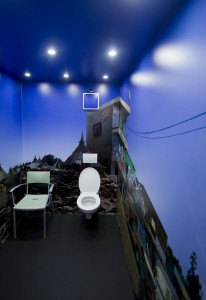WIA < > WIA (Water in Africa < > Water in Austria)

Foto: ARCHIPICTURE Mag. Dietmar Tollerian
The “80+1 – A Journey around the World” exhibition’s project entitled WIA < > WIA -Water in Africa – Water in Austria, which was purportedly to have linked up Linz via the internet to an African village’s well in order to gather data in real time about African water usage and transmit the data to Linz where it would be used to flush a toilet with the exact same amount of water, was actually completely fabricated. Nor does there exist an artist named Melissa Fatoumata Touré. Both the artist and the entire project are fictions that I invented, and I intentionally did not inform Ars Electronica of this fact. Nevertheless, when doubts began to mount about the reality of this project, it seemed advisable to go public with the truth and state the background facts and circumstances.
In a public call for the tender of ideas in 2008, Ars Electronica invited artists and scholars to submit proposals for a virtual journey around the world, a medial reinterpretation of the trip protagonist Phileas Fogg took in Jules Verne’s novel Around the World in 80 Days. The aim is to thereby call attention to important issues that affect the population of the whole world.
I took the journey’s belletristic basis (as specified by Ars Electronica itself) as an occasion to consider an installation that would be played out in the realm of fiction just like the novel that gave the whole project its name. The internet as the filter in the communication between Ars Electronica and me played an essential role in this by effectively concealing my true identity for a long time. Inventing and subsequently maintaining a fictional identity by means of digital communication have also simultaneously been the core of my artistic contribution to this exhibition.
The WIA < > WIA installation I proposed via a fictitious person named Melissa Fatoumata Touré unfortunately deals with a very serious issue: the fact that not all people in this world have enough clean drinking water at their disposal. The installation is set up in such a way that it puts forth a real solution to this very real problem: the operation of the installation will help to raise money that will be used to subsidize the building of wells in Africa.
These facts are not changed in the least by the otherwise fictive character of the installation. The data that are being fed to the toilet in Linz don’t come from an African well hooked up to the internet but rather from a random number generator. And the panoramic image of the African village square that adorns the walls of the toilet is actually a Photoshop collage assembled using images freely available online.
An integral part of a fiction, if it’s to be perpetrated in such a way that people will give it credence, is skepticism. What was originally perceived by the project organizer and audiences as a real project by a real person was revealed, at a certain point, to be a deception. From an artistic perspective, I was interested in exploring this borderline. How long does one keep believing in information? At what point does one classify it as false? And how can I, someone who disseminates fictitious information, use my influence to cause it to be believed nevertheless? This is why the way in which the project is set up calls attention to a problem that, although it has always existed in all media, has been significantly exacerbated by the speed and multilayered complexity of global digital communications: the increasing importance of being able to autonomously assess the extent to which information is true. Or to put this in different terms: to be cognizant of ones occasional impotence in this regard. After all, one is not always in the enviable situation of being able to correctly classify the quality of a piece of information or its source.
I custom-tailored both the WIA < > WIA installation as well as the fictional artist Melissa Fatoumata Touré to the wishes expressed by the project organizers in their published call for submissions.
Doing so afforded me the opportunity to very vividly treat the subject of fraudulent identity and falsified information on the basis of a concrete example in an exhibition context since it’s my opinion that 80+1 – A Journey around the World, a project structured precisely in such a way as to take advantage of all modes of electronic data transfer, should also shed light on this dark side of the internet.
I’m pleased that discovery on the part of Ars Electronica has now brought closure to this undertaking.
Since sustainably providing all people with clean drinking water is more important than the subject of misinformation in the media—indeed, is truly a matter of life or death—I’m also happy that the installation will remain in operation until the conclusion of 80+1 – A Journey around the World and will continue to raise donations to finance the construction of actual wells in Africa.
Electronics: Zoumana Habib Tounkara
Programming: Djelimady Samaké
Internet access: Ballaké Touré
Sibiri Touré, Soumano Dieneba Touré
Sponsored by Niklas Roy
http://www.niklasroy.com/shows/index.htm
